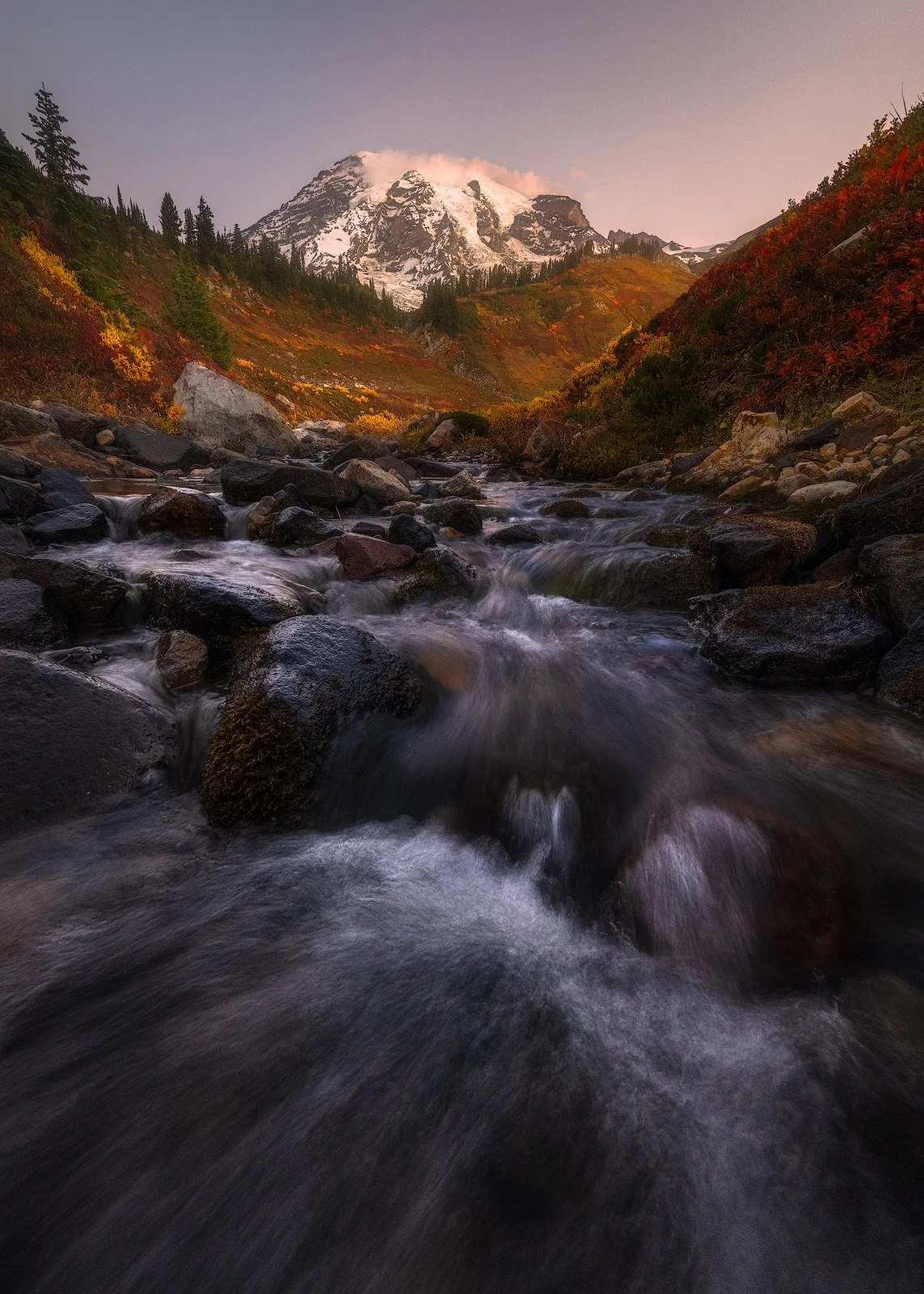 Image 1 of 1
Image 1 of 1


Ember River
In the waning days of autumn, Myrtle Falls pours through a tapestry of color at the foot of Mount Rainier. Water glides in silver ribbons over dark volcanic stone, each cascade softening into silk before disappearing beneath crimson brush. Around it, the valley blazes—huckleberry, maple, and larch igniting the slopes in tones of fire and gold. The air hums with the scent of wet earth and alpine pine, sharpened by the chill that drifts down from the glacier above. Light gathers along the ridge, diffused and amber, brushing the snowfields of Rainier in the faint glow of alpenglow.
The mountain rises like a cathedral—immense, patient, and ageless—its summit veiled in a pale halo of cloud. The contrast is magnetic: motion below, stillness above; warmth against the blue austerity of ice. Every detail feels deliberate, from the braided threads of water to the crisp outlines of autumn leaves caught mid-fall. Time slows here; even the wind seems to move in rhythm with the river’s pulse.
As dusk deepens, the valley becomes a study in light’s persistence. Gold turns to ember, ember to ash, yet the falls keep their quiet song. The mountain reflects the last color of day, holding it for a breath before releasing it to night. It is a harmony of elements—water shaping stone, fire meeting frost, the fleeting brilliance of fall mirrored against permanence.
Ember River is a portrait of convergence: the restless flow of a season meeting the eternal calm of the peak. In that meeting lies balance—heat within cold, motion within stillness—a reminder that even as light fades, beauty continues to burn softly through the dark.
In the waning days of autumn, Myrtle Falls pours through a tapestry of color at the foot of Mount Rainier. Water glides in silver ribbons over dark volcanic stone, each cascade softening into silk before disappearing beneath crimson brush. Around it, the valley blazes—huckleberry, maple, and larch igniting the slopes in tones of fire and gold. The air hums with the scent of wet earth and alpine pine, sharpened by the chill that drifts down from the glacier above. Light gathers along the ridge, diffused and amber, brushing the snowfields of Rainier in the faint glow of alpenglow.
The mountain rises like a cathedral—immense, patient, and ageless—its summit veiled in a pale halo of cloud. The contrast is magnetic: motion below, stillness above; warmth against the blue austerity of ice. Every detail feels deliberate, from the braided threads of water to the crisp outlines of autumn leaves caught mid-fall. Time slows here; even the wind seems to move in rhythm with the river’s pulse.
As dusk deepens, the valley becomes a study in light’s persistence. Gold turns to ember, ember to ash, yet the falls keep their quiet song. The mountain reflects the last color of day, holding it for a breath before releasing it to night. It is a harmony of elements—water shaping stone, fire meeting frost, the fleeting brilliance of fall mirrored against permanence.
Ember River is a portrait of convergence: the restless flow of a season meeting the eternal calm of the peak. In that meeting lies balance—heat within cold, motion within stillness—a reminder that even as light fades, beauty continues to burn softly through the dark.
